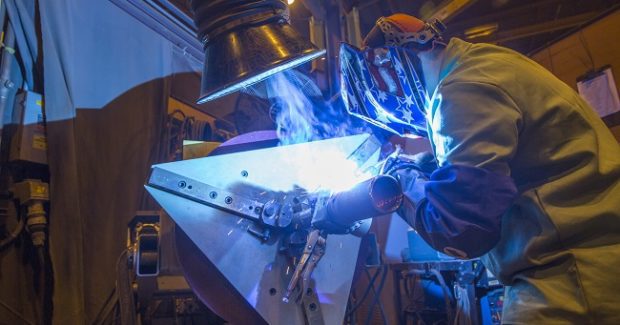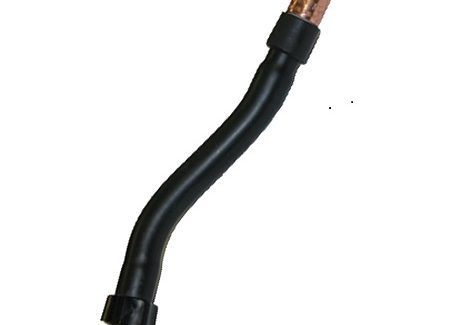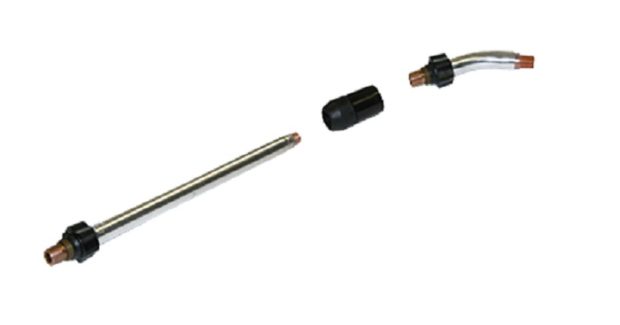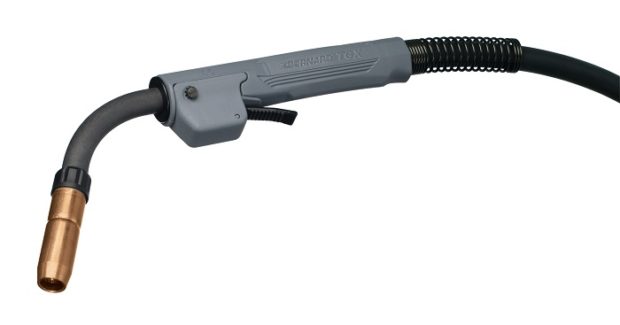The Right MIG Gun Neck Can Improve Weld Access and Operator Comfort
There are rotatable necks, flex necks, ones with various bend angles and lengths, neck couplers and custom necks. Which one is the right style to use? Here are some considerations to remember that will help you choose the right MIG gun neck for your application.
Posted: July 3, 2018
In specific applications, optimizing MIG welding gun performance can be a matter of choosing different components for the gun. Selecting the right MIG gun neck improves access to the weld joint, increases operator comfort and can reduce costs in the operation. The biggest factor when choosing a gun neck is to ensure that it provides proper access and visibility to the work. In some applications, the weld joint may be difficult to reach or it may require you to reach down into a groove. A gun neck should provide optimal access to the weld joint so that you can do your best work while maintaining proper ergonomics. In addition to joint accessibility, several other factors play a role in the decision, including the welding process and parameters, the welder’s height, and whether the gun has a curved or straight handle. Keep the following considerations in mind to choose the right MIG gun neck for your application.
FEELING THE HEAT
Certain welding processes and filler metals generate much greater heat during welding, so take that into account when choosing a gun neck. Pulsed welding processes, the use of metal-cored wires and even certain materials, including stainless steel and aluminum, all generally create more heat during welding. The welding parameters – including amperage, volts, joint configuration and distance from the welder to the joint – also impact the amount of heat produced and felt by the welder. In applications with high heat, a standard short gun neck can cause the heat to radiate through the glove and into the welder’s hands. It’s recommended to use a longer gun neck in these situations to keep the heat farther away. Another good rule of thumb to remember is that the larger the wire diameter being used, the longer the gun neck should be.
STANDARD NECKS
Standard necks for MIG guns are available in a range of options, with varying angles and material types:
- Aluminum armored necks can withstand abuse and offer outstanding heat dissipation. They are typically available in fixed and rotatable styles, and some models require no tools to rotate. These necks, which come in 30 deg, 45 deg, 60 deg and 80 deg angle options, are a good all-purpose choice for many welding applications.
- Black polymer armored necks, available in a 60 deg angle, contain a thick copper wall with a conductor tube interior so that they don’t radiate or reflect heat as quickly. This insulation from the heat makes them a good choice for higher-amperage welding applications. Be aware that black polymer armored necks can become brittle and break since the high temperatures, over time, can break down the exterior tube.
Choosing between these standard neck options is often a balance of application requirements and welder preference. The same is true for choosing a neck angle. The style of the gun handle, however, is also a determining factor in selecting the right neck angle. When using a curved handle, it’s often more comfortable to use a 60 deg neck than a 45 deg neck. With a straight handle, a 45 deg neck is typically better suited due to natural hand placement. A welder’s height also impacts proper neck angle: a taller welder may want to use a 60 deg neck, while a shorter welder may prefer a 45 deg neck for comfort.
FLEX NECKS
In applications where a standard neck can’t provide proper access to the weld joint, consider using a flex neck that can be bent into a desired shape or angle to access hard-to-reach or narrow areas. Some flex necks have a bend radius up to 80 deg. These necks are typically available in 6 in and 8 in lengths for straight and curved handles. Because flex necks can be changed, rotated or bent without tools, this saves time and labor.
A neck coupler is an accessory that allows a flex neck to be added to the top of an existing standard neck. This can be used when a longer neck with flexibility is needed to get into hard-to-reach areas. Some flex necks can also be used with an easily removable jump liner for quick changeover. Jump liners replace only the most commonly worn and clogged liner area in the neck bend to reduce downtime for liner changeover. A jump liner connects the standard liner at the back of the neck and runs through the neck up to the contact tip.
Because a jump liner allows for quick and easy neck change-out, the gun can be easily adapted to fit multiple applications. For example, flex necks and rotatable necks are frequently used in shipbuilding. A welder may be in the ship’s hull and need multiple neck styles to access different weld joints. Instead of bringing several welding guns to the work area, a jump liner allows the welder to quickly unscrew one neck and thread another one on without changing or trimming the liner. An operation can also reap cost savings since jump liners are less expensive than standard liners and quicker to install.
SPECIALTY NECKS
When available standard or flex necks don’t provide proper weld joint access, specialty necks can be created. Multiple lengths and bends are available for limited access positions and improved operator comfort. These necks are specially designed by manufacturers to fit the specifications of the application. Because producing a quality weld hinges on optimal access to the joint, in some cases a custom neck can provide the best accuracy and results.
FINAL THOUGHTS
Many neck options are available for MIG welding guns, including rotatable, flex, various bend angles and lengths, neck couplers and custom necks. Choosing the right style can improve your comfort and maneuverability especially with hard-to-access welds. When you’re unable to reach your weld joints comfortably using a standard neck, consider adding a specialty or custom neck to your toolkit.




















